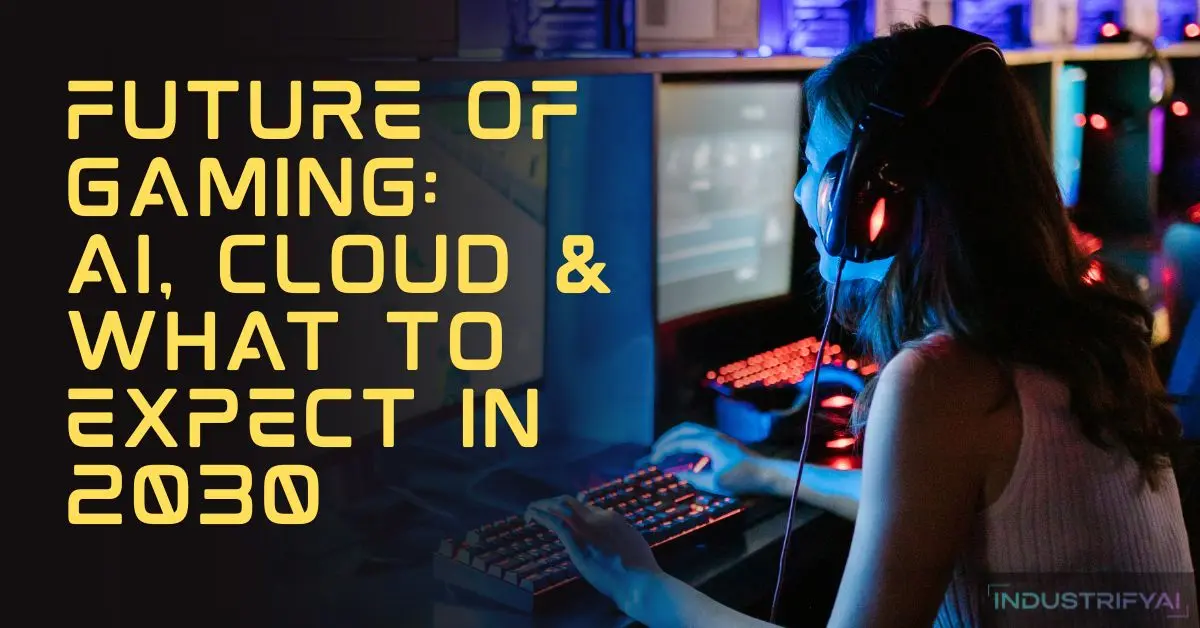
Gaming in 2030 Will Be Unrecognizable With Sentient AI Worlds and Limitless Cloud-Powered Experiences
Imagine starting a game with no download and no loading screen. The world you enter is huge and changes based on what every player does. Furthermore, the characters you meet are not just robots. They are smart beings who remember you and talk to you, creating new challenges just for you. This is not science fiction. In fact, this is the future of gaming.
By 2030, the idea of a video game will be completely different. The line between our world and virtual worlds is blurring. This change is happening because of three amazing technologies: cloud access, true artificial intelligence, and immersive hardware. This evolution depends on new gaming services and the deep use of AI in gaming.
The Cloud Revolution: Your Games, Anywhere, Instantly
For many years, powerful hardware limited great gaming. The power of your console or PC defined your experience. However, the cloud is now breaking those chains. By 2030, this change will be complete.
Key Technology: Widespread 5G and future 6G networks will be essential. In addition, advanced edge computing will help eliminate lag almost completely.
Real-Life Example: For instance, imagine playing a beautiful game like a future Cyberpunk sequel on your tablet while on a train. The amazing world loads instantly. It has details that even today’s best consoles cannot handle. This works because a powerful remote server streams the game to you. Top gaming services like Xbox Cloud Gaming and NVIDIA GeForce NOW lead this new era. Consequently, they turn every screen you have into a portal for top-tier gaming. Waiting for a 100GB download to finish will feel very old-fashioned.
The Dawn of Sentient Worlds: The Impact of AI in Gaming
This is the biggest change of all. For a long time, AI in gaming was just simple, scripted behavior. It only created a fake sense of intelligence. Now, real intelligence is coming to games.
Key Technology: Developers are now putting Generative AI and Large Language Models (LLMs) into game engines.
Real-Life Example: For example, companies are already using tools like NVIDIA’s Avatar Cloud Engine (ACE) to build new experiences. In a future RPG, you won’t just pick a dialogue option. Instead, you will speak to a character directly. That character will understand you, remember what you did, and create a unique reply. It might even generate a new quest just for you. This use of artificial intelligence for games will finally make worlds feel alive. They will be full of dynamic characters who have their own goals, creating a story that is truly yours.
Building Smarter, Not Harder: The Future of AI Game Development
The way people make games is also changing. AI is becoming an essential partner for developers. It handles the boring tasks. As a result, human creators can focus on vision and art.
Key Technology: AI tools for Procedural Content Generation (PCG) and AI-assisted coding are changing AI game development.
Real-Life Example: In the past, a huge team needed years to build a large open world. With AI tools, a small indie team can now generate a massive, unique landscape very quickly. The AI can also help with coding, animation, and finding bugs. Therefore, it lowers the barrier to entry for making games. This will lead to an explosion of creative and new gaming experiences.
Beyond the Screen: The Promise of True Immersion
For those who want to step right inside their games, the technology of 2030 will offer total immersion. Gaming will become an experience for all your senses.
Key Technology: Lightweight standalone XR headsets, full-body haptic feedback suits, and biometric sensors will be common.
Real-Life Example: Imagine a VR game with friends. You see their characters, but you also see their real facial expressions. As you explore a haunted house, a haptic suit lets you feel a cold wind and vibrating floors. The game even reads your heart rate with sensors and adjusts the scares. This creates a perfectly paced and personal experience.
The Road Ahead: Challenges on the Path to 2030
Of course, this amazing innovation also creates big challenges. The path to 2030 has many obstacles.
- Rising Costs: Player expectations are high. This drives development budgets to levels that are hard to manage, even with AI.
- AI Ethics: How do we stop people from using AI characters for bad purposes? Also, what about the data privacy issues when games learn everything about us?
- Digital Ownership: The debate over blockchain, NFTs, and who owns our digital items will grow. This is because virtual assets are becoming more valuable.
- Finding Good Games: AI might help create a flood of new games. So, how will we find the quality ones in a crowded market?
Recent Gaming News: A Snapshot of Tomorrow
The latest gaming news already points to this future:
- Ubisoft recently showed its new “NEO NPC” technology. It allows for unscripted talks with characters, building a foundation for the future.
- Microsoft continues to spend billions on its cloud network. It openly says that “cloud-native” games, which can only run on servers, are a key part of its strategy.
Frequently Asked Questions (FAQ)
Will cloud gaming make consoles obsolete by 2030? Not entirely, but their role will shift. Consoles might become simple streaming devices. Hardcore PC gamers will still want the absolute best performance. For most people, however, special hardware will no longer be needed.
Q. How will AI in gaming change storytelling?
It will change stories from a set script to a dynamic narrative. The player and the developer will co-create the story through unique actions. This will make every playthrough feel very personal.
Q. What is generative AI game development?
It means using AI to create game content. This includes things like worlds, characters, dialogue, and music. It is a powerful tool that helps human developers work faster and create new things.
Q. Will I need a VR headset to play big games in 2030?
Probably not. Many games will offer great VR modes, but access is important. Therefore, you will likely be able to play the biggest titles on any device, from TVs to tablets to headsets.
Conclusion
The future of gaming is a mix of easy access, smart technology, and deep immersion. It is a future where our games are everywhere. The worlds inside them are alive. Moreover, the experiences can engage all of our senses. The industry must still solve serious technical and ethical problems. However, the final goal is clear. It is not just about making more realistic graphics. It is about designing more meaningful, personal, and unforgettable realities.

